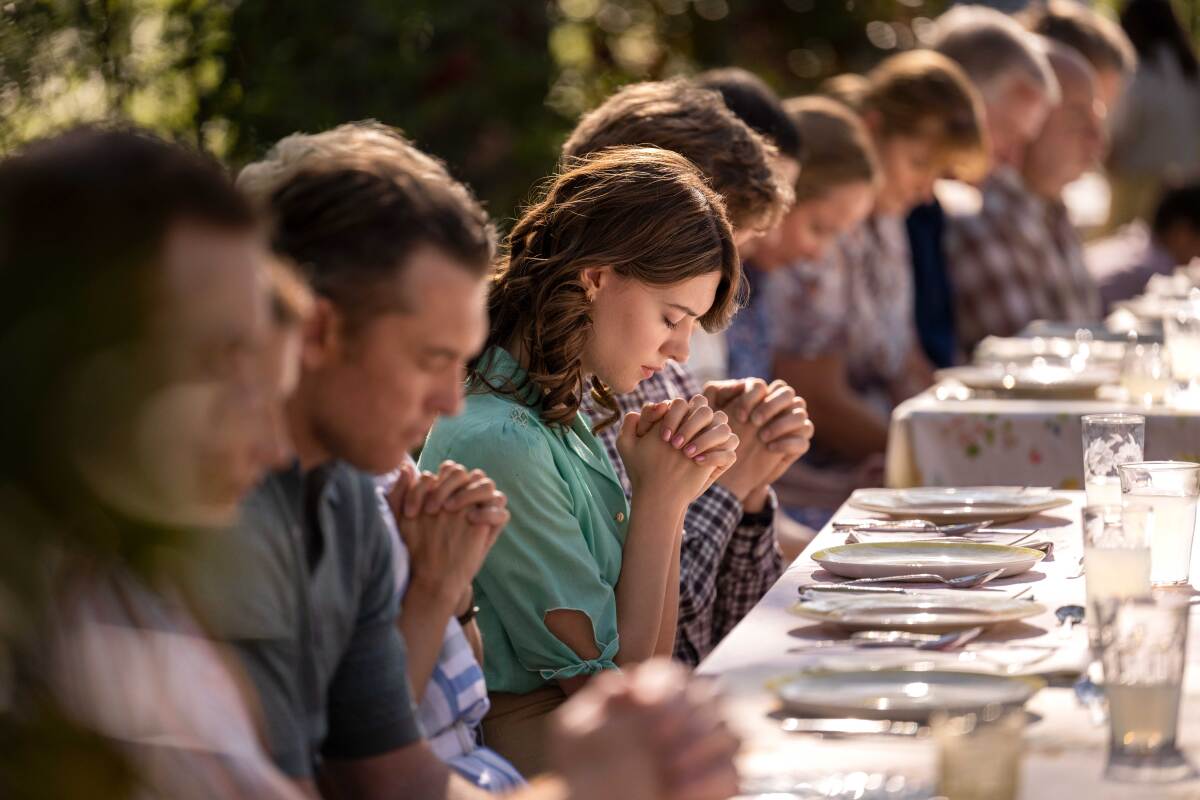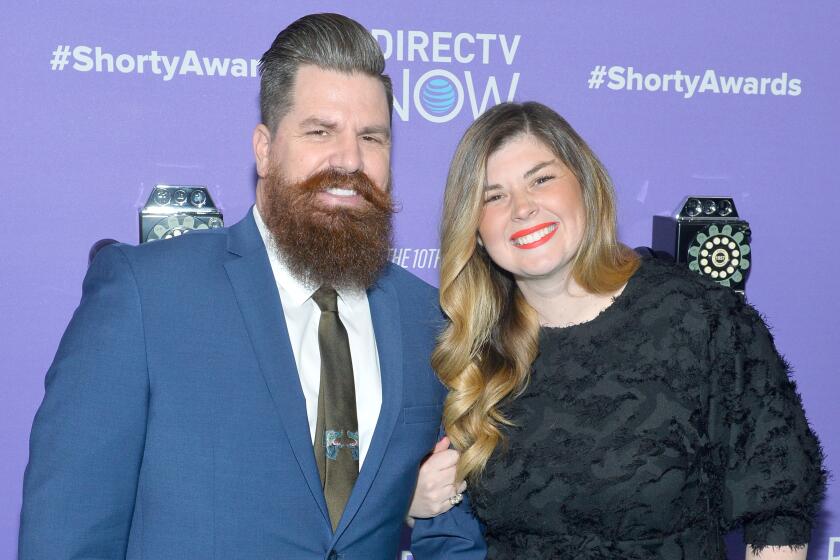If this new TV show outrages the Mormon church, ‘they have themselves to blame’

- Share via
Dustin Lance Black first picked up a copy of “Under the Banner of Heaven: A Story of Violent Faith” nearly two decades ago. For someone who was raised in a conservative Mormon household and had since left the faith, it felt dangerous.
“The [Latter-day Saints] church I grew up in encourages members not to dig into the past, to doubt one’s doubts, to put your questions on a shelf,” said Black. Jon Krakauer’s propulsive nonfiction bestseller uses a horrific double murder committed by fundamentalist Mormon brothers in 1984 to explore the turbulent history of the Church of Jesus Christ of Latter-day Saints, its renunciation of plural marriage in 1890 and the origins of radical polygamist sects in which child sexual abuse is widespread.
When “Under the Banner of Heaven” was published in 2003, the Mormon Church issued a full-throated denunciation of the book, calling it “not only a slap in the face of modern Latter-day Saints, but also a misunderstanding of religion in general.”
The complete guide to home viewing
Get Screen Gab for everything about the TV shows and streaming movies everyone’s talking about.
You may occasionally receive promotional content from the Los Angeles Times.
But to Black, it was a revelation: “I was sometimes angry that so much about my own faith had been withheld from me, but I was also heartened that I wasn’t insane, that my doubts were legitimate,” says the Oscar-winning “Milk” screenwriter, who grew alienated from the church as a teenager because of how it handled his mother’s physically abusive marriage. “I didn’t understand why it should be life-and-death to believe.”
Similar themes animate Black’s TV adaptation of “Under the Banner of Heaven,” now streaming on Hulu, which reimagines Krakauer’s book as a gripping detective story that asks provocative questions about the nature of faith and the dark side of religious fervor. Though largely sympathetic in its portrayal of mainstream Mormons, it is also unflinching in depicting the church’s bloody legacy.
Krakauer, credited as a consultant on the series, expects it will rattle an organization that has been reluctant to reckon with its controversial — and relatively recent — past.
“They think they’re justified in censoring their history, that all history should be faith-affirming,” Krakauer says. “They hated my book, and I think they’re gonna go crazy about this.”

The long-gestating series — produced by FX and originally planned as a feature to be directed by Ron Howard — follows police officers Jeb Pyre (Andrew Garfield) and Bill Taba (Gil Birmingham) as they investigate the ritualistic murder of a young Mormon mother, Brenda Lafferty (Daisy Edgar-Jones), and her infant daughter, Erica, in a sleepy corner of suburban Utah. The detectives initially suspect Brenda’s husband, Allen (Billy Howle), of the crime, but soon learn that his brothers Dan and Ron (Wyatt Russell and Sam Worthington), once exemplary mainstream Mormons, have descended into bellicose fundamentalism.
As they uncover the truth behind the gruesome slaying, the series flashes back to violent moments in LDS history, including the murder of founder Joseph Smith in 1844, inviting viewers to draw connections between the timelines.
“The Real Housewives of Salt Lake City” adds a novel ingredient — Mormonism — to the usual pettiness, plastic surgery and conspicuous consumption.
Aside from the detectives — fictional characters Black devised to tie together the disparate strands of the book — the showrunner made a concerted effort to stick to the facts. He spent years doing his own research: corroborating the information in Krakauer’s book, reading up on Mormon history and enlisting consultants to ensure the authenticity of details as minute as the correct regional pronunciation of Zion. (Rhymes with “lion.”) The finished series sheds light on closely guarded aspects of the faith, including sacred temple ceremonies rarely witnessed by outsiders, as well as more mundane traditions, such as Family Home Evening and CTR rings.
This research took Black to Idaho, where he met with surviving members of Brenda’s family, who shared journals and letters that shed new light on the events preceding her death. It took him to Utah, where he interviewed one of Brenda’s unrepentant killers, Dan Lafferty, in prison and visited with other members of the Lafferty family because, he says, “I wanted to understand, in a very detailed way, what went on in this home that created these sons.” And it took him to the Arizona-Utah border, where he toured the fundamentalist community known as Short Creek.
Black, who has family members and friends who remain active Mormons, even met with church officials in Salt Lake City, urging them to reach out if there was anything he should know about the subjects explored in the book. (He says they didn’t take him up on the offer.)

“If the Mormon church is unhappy with me for doing this, they have themselves to blame,” Black says. “The Mormon Church taught me if it’s worth doing, it’s worth doing right. Put your shoulder to the wheel. And I have worked really hard to get it right.”
The Church of Jesus Christ of Latter-day Saints did not respond to The Times’ requests for comment.
Krakauer, who’d seen his book “Into Thin Air” made into “a really bad TV movie,” was initially wary of allowing anyone to option “Under the Banner of Heaven.” But his niece, filmmaker Shannon Costello, urged him to return the numerous phone calls he’d received from Imagine Entertainment.
Executive producer Brian Grazer says he was drawn to the book because it was at once a “riveting thriller and a cautionary tale about the dangers of fundamentalism.” He and Howard considered just one writer for the adaptation: Black, who had worked with Grazer on the biopic “J. Edgar” and written for “Big Love,” the HBO drama about a polygamist family in Salt Lake City. Krakauer too was won over by Black’s vision, and agreed to sell the rights to his book.
“I didn’t want it to just be a true-crime, grisly murder thing. The larger issues about fundamentalist faith — and the hazards thereof — are really important to me,” Krakauer says.
An alleged ‘construction Ponzi scheme’ involving the series ‘Home Work’ threatens to tarnish the reputation of TV’s hottest home renovators.
But by his own account, Black struggled to capture the sweeping scope of the book in a two-hour feature. He wrote countless drafts that swelled to hundreds of pages in length. The project went dormant for a few years, then the team at Imagine decided to revisit it as a limited series — a medium that has rescued many a tricky book from development hell.
“Long-form was the right way to crack a fascinating, tragic family story,” says Howard, an executive producer on the series.
A breakthrough came when Black devised the fictional detectives who serve as audience proxies and lend the story an element of suspense. “Without the investigative tool, it felt academic,” he says. “And I didn’t want it to feel academic.” (Black met with actual investigators on the original case who, though helpful, asked not to be depicted in the series, which is also why the murder takes place in the fictional East Rockwell.)

Bill Taba is a member of the Paiute tribe, which lived in Utah well before the arrival of LDS pilgrims in the 19th century, making him “local yet an outsider,” says Black. Jeb Pyre, meanwhile, is a rank-and-file Mormon and family man who finds he is no longer able to “keep his questions on a shelf,” to use an adage repeated throughout the series, as he tries to understand what drove the Lafferty brothers to commit an act of “blood atonement.”
“Because of the simple fact that he needs to do his job, he has to face all of the deeper truths about his faith, and it’s really incredibly painful,” says Garfield, who was intrigued by the specific challenges of being a Mormon detective: “How do you interrogate someone when you’re conditioned to be patient, kind and gentle all the time? How do you interrogate a fellow Mormon, a person that you see as a part of your extended family?”
The publication of “Under the Banner of Heaven” kicked off a period of pop culture fascination with Mormonism and its offshoots. Yet unlike the messy polygamists of “Sister Wives,” the drama-prone “Real Housewives of Salt Lake City” or the comically naive missionaries in “The Book of Mormon,” Jeb is never portrayed as ridiculous.
Garfield leaned heavily on Black to field his spiritual questions and found “there was a strange kind of love there for the faith,” he says.
Netflix’s “Unorthodox” recreates the customs of the Hasidic Jewish community in painstaking detail. We went behind the scenes to find out how they did it.
To prep key cast and crew, Black created a massive Dropbox folder filled with photos, videos and documents. He gave books like “No Man Knows My History,” Fawn Brodie’s influential scholarly biography of Joseph Smith, to the actors playing historical figures.
And he sent Garfield and other cast members to Utah before production started last year because, he says, “There’s no book that’s going to take the place of meeting Mormons.” (In a nod to financial reality over geographical accuracy, the series was filmed in Alberta, Canada.)
Black officially employed two consultants with expertise in LDS history and tradition: Lindsay Hansen Park, a feminist writer and executive director of the Sunstone Education Foundation, a nonprofit supporting Mormon studies; and Troy Williams, a formerly devout Mormon who now runs Equality Utah, an LGBTQ rights group, and has been described as Utah’s answer to Harvey Milk.
Production designer Renee Read and costume designer Joseph La Corte also spent months buried in research in order to visually build the world of the Mormons over two centuries. Among many other tasks, Read re-created a massive mural inside the Salt Lake Temple, while La Corte fashioned period-appropriate temple garments for actors to wear beneath their costumes.
“I’m sure the Mormon Church will still find fault here and there. That is their job. But I wanted to make that job very difficult for them,” Black says. “I stand behind the show in terms of how it depicts Mormonism — and not just Mormonism but, frankly, Christianity in America.”
And though he believes he has adequately distinguished between fundamentalist Mormons and mainstream Mormons, Black adds, “I also have been honest about the fact that they share a lot in common, and that many of the things they share in common are misogynistic, dangerous and potentially deadly.”
‘Under the Banner of Heaven’
Where: Hulu
When: Anytime
Rating: TV-MA (may be unsuitable for children under the age of 17)
More to Read
The complete guide to home viewing
Get Screen Gab for everything about the TV shows and streaming movies everyone’s talking about.
You may occasionally receive promotional content from the Los Angeles Times.







